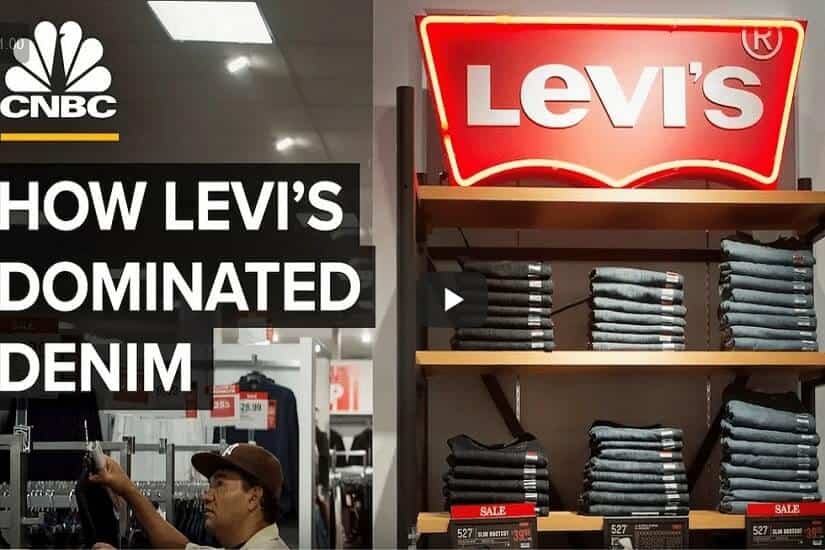How Levi Strauss Dominated Denim

Transcript
What was the most lucrative product to come out of
the California Gold Rush? Not gold. At least, not
for the vast majority of miners, for whom the
Gold Rush was basically a bust. But the merchants
who served those miners? Well, they had a golden
opportunity indeed. All those new miners needed
products, housing, food, and clothing. Lots and
lots of clothing. Enter Levi Strauss. Sound
familiar? Yeah, he should. But hold on a second.
Strauss was a German immigrant who arrived in San
Francisco in 1853 to open Levi Strauss & Co., a
wholesale dry goods business to cater to
California’s exploding population. That went
okay. But it took another 20 years for Strauss’s
real breakthrough: blue jeans. That’s why you
know his name. One of Strauss’s customers, a
tailor from Latvia
named
Jacob Davis, bought denim fabric from Strauss to
sew various products for his customers: tents,
wagon covers, and now, pants. Davis wrote to
Strauss for help to patent and market his
invention: denim pants strengthen with copper
rivets. They received a patent for the pants in
1873. But while jeans are still a worldwide
sensation 150 years later, Levi’s itself hasn’t
always struck gold. The company rose to fame as a
hearty, all-American brand.
Everybody has a Levi’s story. First date, first
kiss, going to college. Everybody has a Levi’s
story, and we’ve capitalized on that. But it has
struggled to maintain the public’s loyalty.
Now, after a rocky recovery, it’s poised to go
public again in 2019. The big question now? Will
this be a boom or bust for the company that
invented jeans?
For its first 70 years, Levi’s were the pant of
America’s working class: miners, ranchers,
factory workers and more. Levi’s dominated the
jean market until 1913, when rival brand Lee
rolled out its Union Alls. A few decades later,
Wrangler introduced its jeans fashioned with felt
seams and deeper watch pockets for the modern day
cowboy.
So competition was heating up. But the denim
market was about to experience a major boost.
How? World War II and the baby boomers. Jeans
made their worldwide debut during World War II as
American soldiers wore the casual pants around
Europe when off-duty.
That kind of got consumers to just see something a
little bit different because everybody was so
much more formal. Men were wearing hats and
suits, ladies wore suits and coats and, you know,
fur scarves. I mean it was a very formal culture,
globally. And I think that was really, like, the
start of this global trend within denim.
When soldiers returned, jeans stuck around. But it
took a boost from the silver screen to transform
jeans from strictly functional to fashion
statement.
John Wayne first popularized denim with his rugged
cowboy characters in popular Western movies
during the 1930s and 40s. But denim’s real
breakthrough came from 1950s Hollywood movies and
the teenagers who watch them. When James Dean
donned jeans and a leather jacket in Rebel
Without A Cause, he kicked off a fashion
sensation. Jeans, leather jackets, those hats,
I mean it was very, very rebellious. It was very
different from what the culture was used to.
Though
Dean wore jeans from Levi’s rival company, Lee,
Levi’s themselves graced the legs of famous stars
in other popular movies.
These films introduced jeans as a symbol of sexy
rebellion to America’s teenagers. Some school
districts even banned students from wearing them.
This growing popularity helped Levi’s expand
nationwide. Young Baby Boomers across the country
wore their Levi’s to the sock hops of the 50s,
the music festivals of the 60s, and the protests
of the 70s.
What makes the Levi brand so successful is their
ability to keep re-engineering and introducing
themselves to the next jeanration. They are one
of the few denim brands that continually maintain
their customer base and find ways to get the new
and upcoming youth market to think about denim
and Levi’s together.
Capitalizing on this success, Levi’s went public
for the first time in 1971, and its sales grew at
an annual clip of 37 percent during the late 70s.
The denim market as a whole was booming, peaking
in 1981 with nearly 590 million jeans sold.
Levi’s and its top two competitors, Lee and
Wrangler, represented over 40 percent of the
denim market. But this denim rush slowed in the
early 1980s. Levi’s, though firmly cemented as an
iconic American brand, began to struggle. First
the company fell behind fashion trends. Amid the
slumping jeans market of the 80s, designer jeans
from Calvin Klein and Jordache came into vogue.
They gave the pants the sex appeal that Levi’s
classic 501s lacked, and consumers bought them
for nearly double the cost of Levi’s. At the same
time, the major clothing retailer VF Corporation
merged with Wrangler’s parent company Blue Bell.
Now, two of Levi’s top competitors for the
classic American jean market, Wrangler and Lee,
were both under VF Corp. Levi’s revenue plunged
78 percent in the first half of 1984, a worrying
stumble for a publicly-traded company. Levi
Strauss’s descendants decided to take on 1.6
billion dollars in debt to buy back the majority
of the company, taking it private and freeing it
from the pressures of Wall Street. It was the
biggest deal of its kind in the apparel industry
at the time.
Once it went private, Levi’s acted fast to compete
in a tough denim market. It closed eleven plants
and laid off 3,600 employees. It invested in
marketing and technology and introduced its
business casual brand Dockers in 1986. Dockers
focused on trendier, non-denim trousers, which
cut into VF Corp’s jean sales. Denim boomed again
in the 1990s. Levi’s sales peaked in 1996 at $7.1
billion dollars. The company was paying its debt
years ahead of schedule, so Strauss’s descendants
borrowed another 3.3 billion dollars to buy back
the rest of the company. But Levi’s still
struggled to stay relevant. It missed the baggy
jeans trend of the 90s and the hip-hugging style
of the early 2000s. Cheaper private label brands
sold at J.C. Penney and Gap ate into Levi’s sales
in the 1990s, followed by new upscale competitors
like 7 For All Mankind, Diesel, and True
Religion in the early 2000s. Battered by
competition, Levi’s sales fell every year from
1997 to 2002. Still saddled with debt, the
company recruited the first non-family member to
serve as CEO: Phil Marineau.
Marineau and his successor, John Anderson, cast
around for solutions. They considered selling the
Dockers brand and teased going public again.
Levi’s sales recovered somewhat by 2007 but fell
again when the financial crash devastated the
garment industry. Some analysts argue that Levi’s
reputation as a classic American brand has seen
the company through fickle fashion trends and
economic woes.
They can ride out the storm. They’re not worried
about being the first and the trendsetter,
they’re worried about maintaining their volume
and their core customer business and achieving
growth within the new customers. But even that
all-American reputation has faded.
The 80s and 90s saw the rapid outsourcing of
garment production from the US to countries with
cheaper labor. This allowed Levi’s competitors to
slash prices, luring customers away from the
Levi’s brand. This flew in the face of both
Levi’s all-American reputation and its
longstanding relationship with its employees.
When the great San Francisco fire burned down the
Levi’s factory in 1906, Levi’s kept paying
workers. And when sales fell during the Great
Depression, Levi’s paid its employees to put in
new factory floors rather than laying them off.
So Levi’s resisted outsourcing. It closed some
plants in the 80s and 90s, but held onto others
until finally closing its last U.S. plant in
2004. When announcing the final plant closures, a
Levi Strauss Company spokesman told NBC News: “We
tried to do our best to maintain manufacturing in
the United States, but we have to be competitive
to survive as a company.” Now, the vast majority
of Levi’s all-American jeans come from China,
Vietnam, Mexico, and elsewhere.
So by the mid 2000s, Levi’s faced massive debt,
sluggish sales, and a waning reputation as an
all-American icon.
They’ve got their base. What they’ve got to appeal
to is sort of break the mold of Levi’s as Levi’s
classic, to increase their fashion-ability and
that so of speak. But they can’t go too far.
Enter Chip Bergh. Bergh, another Levi’s outsider,
took over as CEO in 2011.
The brand lost its way back in the late 90s and
early 2000s. We lost a lot of consumers. We lost
our mojo. I saw this as kind of an enormous
opportunity and an enormous challenge.
He encouraged the company to focus on what worked,
like the core men’s bottoms business, and
strengthen weaker areas. He revamped stores and
its e-commerce site, but found the most success
with women’s jeans. Using its new Eureka
Innovation Lab, an in-house research and design
initiative, sales increased from under 800
million dollars to over one billion dollars in
under three years. Additionally, fashion trends
are finally back on Levi’s’ side. Nostalgia for
the 1980s and 1990s has brought back light wash,
distressed, and mom jeans, and a taste for Levi’s
501s. Kanye West wears a Levi’s vintage trucker
jacket, while his famous family sports Levi’s on
Instagram and in their 2017 Christmas card.
Levi’s even got a taste of the hysteria of a
high-profile sneaker drop when they remade the
Air Jordan IV sneakers in denim in June of 2018.
Finally, Levi’s placed itself prominently in the
public eye. First, in 2013, it signed a 20-year
220 million dollar deal for the naming rights to
the San Francisco 49ers stadium. The stadium and
its employees, including the cheerleaders, are
now plastered with Levi’s advertising. “The
people who attend concerts and NFL games are our
core customers,” Bergh wrote for The Harvard
Business Review. “So this would put our brand
back at the center of the cultural conversation.”
Second, Levi’s joined other retailers and taking
a public stand against gun violence in 2018.
Bergh, a former Army officer, wrote an op-ed for
Fortune promising 1 million dollars in donations
to anti-gun violence activists and five hours of
paid volunteer time each month for Levi’s
employees. He had previously asked customers not
to bring firearms into Levi stores in 2016. Burke
stated that he received threats against Levi’s
Stores and even himself after posting the op-ed,
but he responded that they “pale in comparison to
threats against other activists and the daily
threats of gun violence faced by many across the
country.”
This brand is at its best when we’re at the center
of culture. We were there when the Berlin Wall
fell down. We were there through the riots in the
60s and 70s. So we put the brand back at the
center of culture.
So with innovation, trends, and bold public moves,
Levi seems to be recapturing some its iconic
essence. They consistently captured around 11
percent of the U.S. total denim market from 2012
to 2015, and their annual sales slowly crawled
back up to 4.9 billion dollars in 2017. It was
their highest sales numbers since 1999, and it
happened as the rest of the U.S. jeans market
took a beating.
But this is still a far cry from its 1996 sales.
Staying private helped the company make long term
investments in its business, but it still has
more than a billion dollars in total debt. So
today, with the denim industry set to grow,
Levi’s is once again considering going public in
2019. Sources tell CNBC that Levi’s is aiming to
raise as much as 800 million dollars, which would
value the company at five billion dollars. That
kind of cash could help it finally pay off its
remaining debt and focus on growth. CNBC reached
out to Levi’s for an interview, but they
declined. This potential IPO comes as the parent
company of Lee and Wrangler is splitting its
denim division into its own public company. VF
Corp. announced a decision in August 2018, saying
it wanted to focus on its activewear brands like
The North Face and Timberland. It’s a move some
say indicates its denim brands were weighing on
overall profits. But most analysts maintain that
Levi’s still stands to gain quite a lot from
going public. It could be a golden opportunity to
reclaim its place as an American icon.









